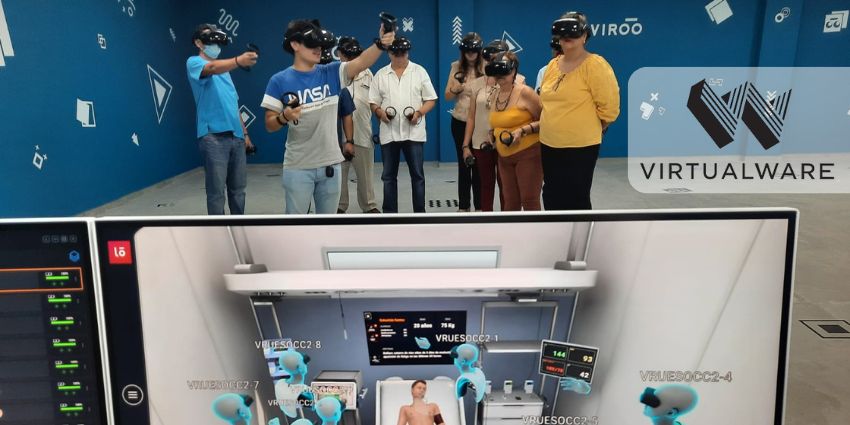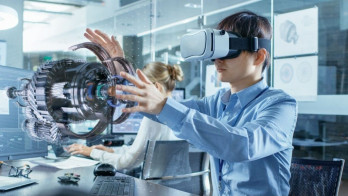Unlocking the power of VR in higher education
As the virtual reality (VR) landscape has evolved, the potential use cases for this immersive technology have grown too. Today, virtual reality is more than just a resource for entertainment; it’s a powerful tool for unlocking better collaboration, productivity, and creativity in a range of environments.
In the educational sector, VR has emerged as an incredible way to transform the way we learn and teach, allowing students to explore and interact with realistic scenarios like never before. With the right resources, educators can empower learners with both soft skills, and the vocational skills they need to thrive in the world of employment.
Here’s your behind the scenes look at the power of virtual reality in higher education.
Why Use VR Technology in Higher Education?
In a 2020 study, PWC found VR unlocks incredible benefits in education. Compared to traditional classroom learners, VR learners completed courses 4 times faster, were 4 times more focused, and were 3.75 times more emotionally connected to the content. Leading VRaaS (Virtual Reality as a Service) vendor Virtualware’s research builds on these insights.
They discovered that 90% of learners were more confident in using their new skills after VR training. Plus, they achieved knowledge retention rates of up to 75%, compared to just 5-10% for other learning methods. Virtual reality in higher education can:
Empower Students with Crucial Soft Skills
Virtual reality learning is a form of “experiential” learning. This means students learn through hands-on, practical simulations of real-world environments. This form of education delivers knowledge retention rates of up to 90%, and is particularly useful for training soft skills.
VR allows students to engage in role-based exercises in realistic environments. With speech analysis and AI, VR systems can comprehensively evaluate students’ verbal communication skills, and provide immediate feedback. They can also empower students to interact with “virtual characters” giving them the confidence they need to collaborate and engage with others more effectively in the real world.
Break Down Boundaries to Education
As higher education campuses become more global, investing in distance learning initiatives, VR offers an opportunity to deliver immersive experiences to every student, regardless of their location. Educational institutions can use VR as a service solutions to create entire virtual campus environments, for year-round lectures, events, networking, and training experiences.
This ensures every student can get the full “classroom” experience, even if they’re unable to attend a classroom themselves. It can even help to recruit new students to colleges and universities, giving them the chance to explore digital twins of campus environments from a distance. One study found VR experiences for colleges like Yale, Harvard and Princeton led to a 27% increase in the number of customers physically visiting campuses.
Improve Student Experiences
VR brings learning to life in a way no other technology can match. It allows users to experiment with scenarios they couldn’t access in a traditional college campus. For instance, the University of El Salvador (UES), the only public higher education institution in the country, has installed 7 virtual reality laboratories in 2022 and 2023 to enhance students’ learning in health, engineering, and architecture.
The Faculties of Medicine, Dentistry, Chemistry, and Pharmacy at UES can develop innovative learning models and create more dynamic and interactive classes using VIROO, the VR platform on which the new labs are based.
This platform enables students to create their own VR content and connect and collaborate in real-time, both in-person and remotely, from the 7 different rooms located in Santa Ana, San Miguel, and San Salvador. They can explore a range of environments without the need to travel. The sessions can even be tailored to suit different students, with specific learning styles, requirements, and skill sets.
With VR, engineering students can use VR to design buildings, history students can explore ancient ruins, and medical students can practice procedures on virtual bodies. Not only do these immersive experiences make the classes more engaging, but they save higher education facilities money on field trips, and resources to enable experiential lessons.
Enhance group learning experiences
VR has the power to significantly improve collaboration between teachers, students, and peers in a classroom. Through avatars, students can interact and build relationships with other people, regardless of their location. Virtual reality platforms also allow educational providers to create environments where distributed students can work together on projects in real-time.
For instance, the Universidad EAN in Colombia, integrated this platform into its academic programs in 2021. Since then, the students keep creating multiple and different VR content on their own, particularly for business and technology fields, continually innovating its teaching materials.
Prepare Students for the Workplace
Perhaps the biggest benefit of VR in higher education is its ability to prepare students for vocational experiences. With VR, higher education facilities can create simulations of typical workplace environments, where learners can prepare for their entry into the working world.
As part of the Basque Government’s strategy to integrate immersive technologies into education, 34 vocational training centers across Spain are being equipped with the VIROO platform, with 25 of those centers having dedicated VR rooms. “This initiative enables interactive, cost-effective, and secure learning experiences, allowing teachers and students to create, manage, and deploy VR resources easily, setting a new standard in VR education” adds Unai Extremo, CEO at Virtualware
Examples of VR in Higher Education
Already, innovative campuses and higher education facilities are discovering the benefits of virtual reality for themselves. At the International Vocational Training Congress in 2023, the Minister of Education in Spain revealed how over 15 new VR training centers located throughout the region were already helping to improve teaching-learning processes and empower students.
Case studies are starting to emerge all over the world. For instance, as part of the UniMetaTech Innovation Centre, (March 2024), a new Immersive Technologies room has been created under the VIROO platform. The aim is to strengthen UNIMETA’s competitiveness in immersive technologies, promote employment and entrepreneurship, and gradually integrate this technology into training procedures, thus enriching educational innovation at UniMetaTech.
The spaces not only give students the power to explore simulated environments for hands-on learning experiences, but they also empower educators.
For instance, using the flexible VIROO platform, the teachers in the academy can easily manage, administer, and adapt learning resources and activities in the labs, tailoring them to different learning levels, and subjects. This allows for a more agile training experience, that can evolve to suit the needs of countless students in different vocational areas over the years.
Bringing Virtual Reality to Higher Education
Colleges and universities constantly strive to invest in the most advanced equipment and resources for their students. Unfortunately, with limited budgets, it’s often difficult to ensure every student has access to the same resources. Often, learners have to share equipment with others, limiting the time they get to enjoy hands-on experiences.
“Virtual reality gives educational facilities more opportunities to scale their learning experiences to all students, giving them the same immersive experience wherever they are. With VR as a service platforms,like VIROO universities can build highly scalable immersive learning environments to suit the needs of every student, and address every subject matter” – Unai Extremo, CEO of Virtualware
Platforms like Virtualware’s VIROO VRaaS system help to empower better knowledge transfer and retention, increase student motivation, and even boost enrolment. Plus, they ensure educational facilities can effectively prepare students for the real world, by immersing them in true-to-life environments and scenarios, that elevate both confidence and skills.
Quelle:




